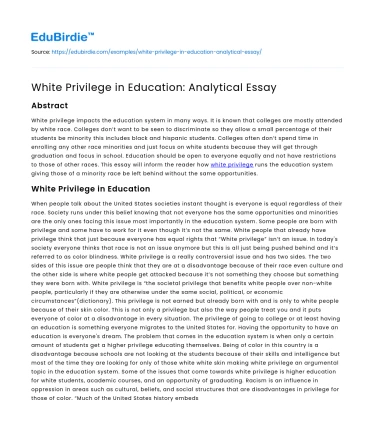Introduction
White privilege, a concept that refers to the societal advantages that white people experience beyond what is commonly experienced by people of color under the same social, political, or economic circumstances, is a pervasive issue in educational systems. Historically rooted in systemic racism, white privilege manifests in education through disparities in access, resources, and opportunities. This analytical essay seeks to unravel the complexities of white privilege within educational contexts, examining its implications on equity and inclusion. By evaluating the structures that perpetuate privilege and exploring counterarguments, this essay aims to propose pathways toward a more equitable educational landscape. Understanding white privilege in education is crucial for fostering an environment where all students, irrespective of their racial backgrounds, can thrive. The discussion that follows intends to highlight specific examples, real-life cases, and authoritative perspectives to elucidate the multifaceted nature of this phenomenon.
Manifestations of White Privilege in Education
White privilege manifests in various facets of the educational system, often beginning with the resources available to different schools. For instance, schools in predominantly white neighborhoods frequently receive more funding, resulting in better facilities, more extracurricular opportunities, and access to advanced coursework. According to the National Center for Education Statistics, public schools serving primarily white students receive significantly more funding per pupil than those serving predominantly students of color (NCES, 2020). This disparity not only affects the quality of education but also perpetuates cycles of inequality by providing white students with a competitive advantage.
Save your time!
We can take care of your essay
- Proper editing and formatting
- Free revision, title page, and bibliography
- Flexible prices and money-back guarantee
Furthermore, the curriculum often centers around Eurocentric perspectives, marginalizing the histories and contributions of people of color. This Eurocentric focus can alienate minority students and hinder their engagement and achievement. According to Banks (2015), multicultural education is often superficial, failing to adequately integrate diverse perspectives and thus maintaining the dominance of white narratives. Additionally, disciplinary policies have been shown to disproportionately affect students of color. The American Psychological Association (2017) reported that black students are three times more likely to be suspended or expelled than their white peers for similar infractions. Such practices contribute to the "school-to-prison pipeline," a concept describing how certain educational policies and practices push students, particularly those from marginalized communities, out of schools and into the criminal justice system.
Counters to the Narrative and Their Limitations
Critics of the white privilege framework argue that it overlooks individual agency and effort, suggesting that success in education is primarily a function of personal determination and resilience. They posit that focusing on race-based privilege diminishes the role of socioeconomic factors that also significantly impact educational outcomes. While it is true that socioeconomic status plays a crucial role, this critique often fails to acknowledge the intersectionality of race and class. As Crenshaw (1989) highlights, individuals experience oppression in varying configurations and degrees of intensity, which means that the intersection of race and socioeconomic status can compound disadvantages.
Another counterargument suggests that policies aimed at addressing racial disparities, such as affirmative action, constitute reverse discrimination against white students. This perspective often garners media attention, but research indicates that such policies are necessary to level the playing field. A study by Bowen and Bok (1998) found that diversity in educational settings contributes to improved critical thinking skills and prepares students for a multicultural workforce. Although these policies may seem preferential, they aim to rectify historical imbalances and create a more inclusive environment. These counterarguments underscore the complexity of addressing white privilege in education and highlight the need for nuanced approaches that consider both racial and socioeconomic factors.
Pathways Toward Educational Equity
To mitigate the effects of white privilege in education, a multifaceted approach is required. One crucial step is implementing culturally responsive pedagogy, which incorporates students' cultural references in all aspects of learning. This approach not only validates the experiences of students of color but also enriches the educational experience for all students. According to Gay (2018), culturally responsive teaching helps bridge gaps in achievement by recognizing and valuing diverse cultural strengths.
Additionally, policy reforms aimed at equitable funding for schools are essential. Allocating resources based on need rather than property taxes can help reduce disparities in educational quality. Furthermore, professional development programs that train educators to recognize and address their biases can foster more inclusive classroom environments. As Ladson-Billings (1995) asserts, teachers play a pivotal role in either perpetuating or challenging systemic inequalities. By equipping educators with the tools to support all students effectively, schools can move toward greater equity and inclusivity.
Conclusion
In conclusion, white privilege in education is a complex issue that perpetuates inequalities and hinders the potential for inclusive academic environments. Although counterarguments exist, they often fail to address the intersectionality of race and socioeconomic status and the historical context that underpins current disparities. By acknowledging the manifestations of white privilege and actively working to dismantle these structures, educational systems can strive toward genuine equity. Implementing culturally responsive teaching, equitable funding policies, and comprehensive educator training are critical steps in this process. Ultimately, fostering an educational environment where all students, regardless of their racial or socioeconomic backgrounds, have equal access to opportunities is essential for societal progress and cohesion.






 Stuck on your essay?
Stuck on your essay?

